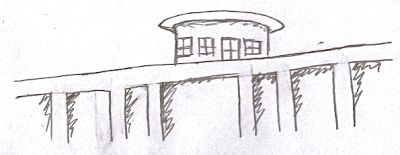For friday's class we were asked to walk around campus and find buildings that represented circles, groups and stacks on and around campus. These all copy things found in nature.
Circles: the sun, moon, sacred spots
Croups: groves of trees, reaching vertical, groups of people
Stacks: mountains, gathering resources
 Circles symbolize sacred spots and importance. In the EUC there are two circular entrance ways (one from each end of the building.) Those circles show the importance of that spot. It is a gathering place for everyone. People come from all different directions and meet each other in that spot. That spot holds a ritual of bringing everyone together. There they all become one. Circles also represent knowledge.
Circles symbolize sacred spots and importance. In the EUC there are two circular entrance ways (one from each end of the building.) Those circles show the importance of that spot. It is a gathering place for everyone. People come from all different directions and meet each other in that spot. That spot holds a ritual of bringing everyone together. There they all become one. Circles also represent knowledge.The tiles on the floor immolate a circle as well with sun bursts starting in the middle and going outward. Those sun-bursts also represent knowledge and a since of importance to the University. The unity of these circles symbolize the entire university. This space being what ties it all together. The circles also emphasize the entrances to the EUC. The circles are also stacks. The circles stand above the rest of the building also emphasizing importance and that they are reaching upwards.
We also talked about stacks. The McIver building is stacked on top of a large set of steps and can be seen from further away. The proportion of this building to the rest stands out. Groups of trees and rectangles converge towards the front of the McIver building showing its importance. Repetition in the groups helps lead your eye towards that building.
 Groups can be found in many places. One in particular caught my eye near the Moore building. In the middle of the walkway there was a group of trees but within the group of trees are groups of squares. Four trees are located at each corner of the square. The six squares grouped together create a rectangle. The repetition of all the squares creates a pattern and balances out the space. The rectangle creates a sense of unity.
Groups can be found in many places. One in particular caught my eye near the Moore building. In the middle of the walkway there was a group of trees but within the group of trees are groups of squares. Four trees are located at each corner of the square. The six squares grouped together create a rectangle. The repetition of all the squares creates a pattern and balances out the space. The rectangle creates a sense of unity.AND NOW FOR THE BIG QUESTION:
Do environments influence RITUALS or do rituals influence ENVIRONMENTS?I feel as if environments influence rituals. The way an environment is shaped creates the rituals that go on within the space. People move within a space according to how the space is designed.





Great blog post and varying observations! Good information paired with diagrams, images, and text help your post flow as a reading. In response to the on-going argument, "Do environments influence rituals, or do rituals influence environments," I would encourage you to explore that deeper. Let's propose a space is being particularly designed for a ritual. Would the environment still influence it, or would the ritual influence the environment?
ReplyDelete